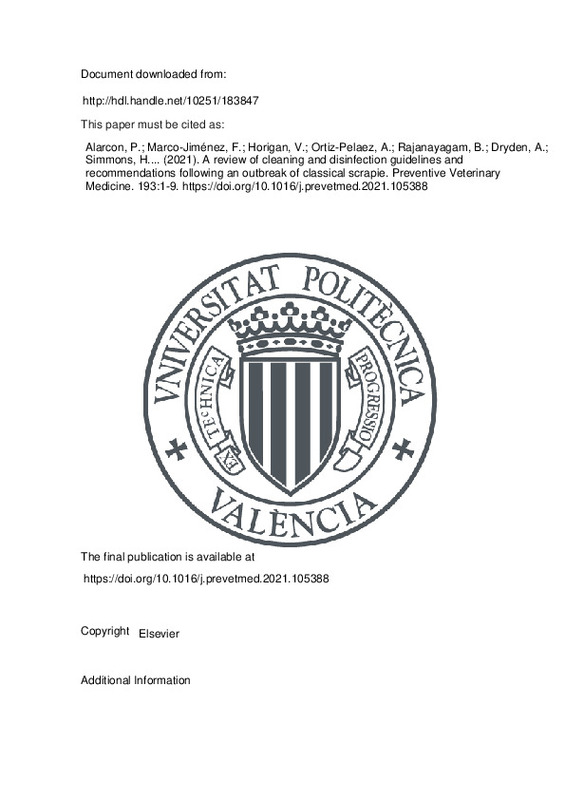JavaScript is disabled for your browser. Some features of this site may not work without it.
Buscar en RiuNet
Listar
Mi cuenta
Estadísticas
Ayuda RiuNet
Admin. UPV
A review of cleaning and disinfection guidelines and recommendations following an outbreak of classical scrapie
Mostrar el registro sencillo del ítem
Ficheros en el ítem
| dc.contributor.author | Alarcon, Pablo
|
es_ES |
| dc.contributor.author | Marco-Jiménez, Francisco
|
es_ES |
| dc.contributor.author | Horigan, Verity
|
es_ES |
| dc.contributor.author | Ortiz-Pelaez, Angel
|
es_ES |
| dc.contributor.author | Rajanayagam, Brenda
|
es_ES |
| dc.contributor.author | Dryden, Aidan
|
es_ES |
| dc.contributor.author | Simmons, Hugh
|
es_ES |
| dc.contributor.author | Konold, Timm
|
es_ES |
| dc.contributor.author | Marco, Carmen
|
es_ES |
| dc.contributor.author | Charnley, Judith
|
es_ES |
| dc.contributor.author | Spiropoulos, John
|
es_ES |
| dc.contributor.author | Cassar, Claire
|
es_ES |
| dc.contributor.author | Adkin, Amie
|
es_ES |
| dc.date.accessioned | 2022-07-05T18:05:44Z | |
| dc.date.available | 2022-07-05T18:05:44Z | |
| dc.date.issued | 2021-08 | es_ES |
| dc.identifier.issn | 0167-5877 | es_ES |
| dc.identifier.uri | http://hdl.handle.net/10251/183847 | |
| dc.description.abstract | [EN] Classical scrapie is a prion disease of small ruminants, the infectious agent of which has been shown to be extremely persistent in the environment. Cleaning and disinfection (C&D) after a scrapie outbreak is currently recommended by many governments' veterinary advisors and implemented in most farms affected. Yet, the effectiveness of these procedures remains unclear. The aim of this study was to review existing literature and guidelines regarding farm C&D protocols following classical scrapie outbreaks and assess their effectiveness and the challenges that translation of policy and legislative requirements present at a practical level. A review of the literature was conducted to identify the on-farm C&D protocols used following outbreaks of scrapie, assess those materials with high risk for persistence of the scrapie agent on farms, and review the existing evidence of the effectiveness of recommended C&D protocols. An expert workshop was also organised in Great Britain (GB) to assess: the decision-making process used when implementing C&D protocols on GB farms, the experts' perceptions on the effectiveness of these protocols and changes needed, and their views on potential recommendations for policy and research. Outputs of the literature review revealed that the current recommended protocol for C&D [1 h treatment with sodium hypochlorite containing 20,000 ppm free chlorine or 2 M sodium hydroxide (NaOH)] is based on labo-ratory experiments. Only four field farm experiments have been conducted, indicating a lack of data on effec-tiveness of C&D protocols on farms by the re-occurrence of scrapie infection post re-stocking. Recommendations related to the control of outdoor environment, which are difficult and expensive to implement, vary between countries. The expert workshop concluded that there are no practical, cost-effective C&D alternatives to be considered at this time, with control therefore based on C&D only in combination with additional time restrictions on re-stocking and replacement with non-susceptible livestock or more genetically resistant types, where available. Participants agreed that C&D should still be completed on scrapie affected farms, as it is considered to be "good disease practice" and likely to reduce the levels of the prion protein. Participants felt that any additional protocols developed should not be "too prescriptive" (should not be written down in specific policies) because of significant variation in farm types, farm equipment and installations. Under this scenario, control of classical scrapie on farms should be designed with a level of C&D in combination with re-stocking temporal ban and replacement with livestock of limited susceptibility. | es_ES |
| dc.description.sponsorship | The APHA would like to thank all the expert contributions at the workshop. This study was funded by Defra (UK) under Project SE1960 and the Government of education and science of the Generalitat Valenciana (Spain) | es_ES |
| dc.language | Inglés | es_ES |
| dc.publisher | Elsevier | es_ES |
| dc.relation.ispartof | Preventive Veterinary Medicine | es_ES |
| dc.rights | Reconocimiento - No comercial - Sin obra derivada (by-nc-nd) | es_ES |
| dc.subject | Classical scrapie | es_ES |
| dc.subject | Decontamination | es_ES |
| dc.subject | Disinfection | es_ES |
| dc.subject | Persistence | es_ES |
| dc.subject | Prion | es_ES |
| dc.subject.classification | PRODUCCION ANIMAL | es_ES |
| dc.title | A review of cleaning and disinfection guidelines and recommendations following an outbreak of classical scrapie | es_ES |
| dc.type | Artículo | es_ES |
| dc.identifier.doi | 10.1016/j.prevetmed.2021.105388 | es_ES |
| dc.relation.projectID | info:eu-repo/grantAgreement/DEFRA//SE1960/ | es_ES |
| dc.rights.accessRights | Abierto | es_ES |
| dc.contributor.affiliation | Universitat Politècnica de València. Departamento de Ciencia Animal - Departament de Ciència Animal | es_ES |
| dc.description.bibliographicCitation | Alarcon, P.; Marco-Jiménez, F.; Horigan, V.; Ortiz-Pelaez, A.; Rajanayagam, B.; Dryden, A.; Simmons, H.... (2021). A review of cleaning and disinfection guidelines and recommendations following an outbreak of classical scrapie. Preventive Veterinary Medicine. 193:1-9. https://doi.org/10.1016/j.prevetmed.2021.105388 | es_ES |
| dc.description.accrualMethod | S | es_ES |
| dc.relation.publisherversion | https://doi.org/10.1016/j.prevetmed.2021.105388 | es_ES |
| dc.description.upvformatpinicio | 1 | es_ES |
| dc.description.upvformatpfin | 9 | es_ES |
| dc.type.version | info:eu-repo/semantics/publishedVersion | es_ES |
| dc.description.volume | 193 | es_ES |
| dc.identifier.pmid | 34098231 | es_ES |
| dc.relation.pasarela | S\442057 | es_ES |
| dc.contributor.funder | Department for Environment, Food and Rural Affairs, UK Government | es_ES |







![[Cerrado]](/themes/UPV/images/candado.png)

